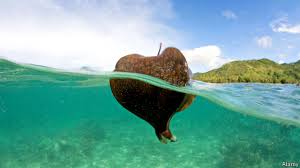Pachyrhynchus weevils are found on most islands in the eastern Pacific Ocean. If these weevils could fly, that would not be surprising. But they cannot.
在東太平洋的大部分島嶼中都發現了球背象鼻蟲。如果這些象鼻蟲會飛的話,也不稀奇。但是它們不會。
Why they are so widespread is therefore a mystery. But it is one that Wen-San Huang of the National Museum of Natural Science in Taiwan thinks he has solved.
為什么它們分布如此廣布也是個謎。但是臺灣國立自然科學博物的黃文山認為,他已解開了這個謎團。
One theory, which dates back to 1923, is that the beetles drift from place to place,
回到1923年,當時有一種理論認為甲殼蟲總是漂無定所,
buoyed up by a tiny air cavity each has beneath its outer shell, which allows the insects to float.
每只甲殼蟲外殼的下方都有一個微型的氣腔,昆蟲們可以借助這個氣腔漂浮。
Dr Huang's research into the weevils began when he noted that this theory had never been tested.
當時黃博士注意到這個理論從未被驗證過,因此他開始了對象鼻蟲的研究。
He discovered, when he put it to the test, that the beetles do, indeed, float.
在對該理論進行驗證時,他發現甲殼蟲確實會漂浮。
But, as he reports in Experimental Biology, floating in seawater does not do them much good. All 57 adults he tried it with died within two days.
但是,他在實驗生物大會上的報告中表示,在海水中漂浮對它們并沒有什么好處。他在實驗中使用的57只成年甲蟲全部于兩天內死亡。
Clearly, adult weevils are not good sailors.
很明顯,成年象鼻蟲并不是一名好水手。
That does not, however, mean that weevil young are not.
但那并不意味著小象鼻蟲也不是。

Pachyrhynchus weevils have a predilection for laying their eggs inside the fruit of a mangrove-dwelling plant called the fish-poison tree.
球背象鼻蟲偏好把它們的卵產在一種植物的果實中,這種植物被稱為魚毒樹,它們生長于紅樹林中。
This reproduces in a way reminiscent of coconut palms. It drops its fruits into the ocean, which carries them away to germinate on distant beaches.
這種繁殖手段讓人聯想起了椰樹。它將果實落入海洋中,這些果實隨著海水漂到遙遠的海灘上發芽。
Coconuts are protected from being eaten on their travels by having a hard, thick shell.
椰子堅硬的厚殼能夠在旅途中保護它們不被吃掉。
Fish-poison-tree fruit are also protected from hungry sea creatures. But in their case, as their name suggests, the protection is chemical.
魚毒樹的果實也受到了保護不會被饑餓的海洋生物吃掉。但是正如它們的名字一樣,保護它們的是一種化學物質。
Given the relationship between weevils and plant, Dr Huang wondered how beetle larvae would fare if they were deep inside a piece of fruit floating in seawater.
鑒于象鼻蟲和植物之間的關系,黃博士想知道如果象鼻蟲的幼蟲深藏在這種果實里邊,它們是否可以在海中存活。
So he tested this as well. His experiment revealed that such larvae are tolerant of saline conditions.
所以他也對此進行了測驗。他的研究表明這種幼蟲能夠忍耐鹽性環境。
Specifically, of 18 grubs thrown into seawater inside a piece of fruit, two survived for six days.
被扔進海中的果實里邊有18只幼蟲,其中有2只存活了6天。
Moreover, these larvae went on to develop into healthy, sexually mature adults.
而且,這些幼蟲繼續發育并長成了健康、性成熟的成年蟲。
Two larvae out of 18 surviving for six days at sea might not sound particularly impressive.
18只中2只在海上存活6天,這個數字或許聽起來沒那么引人注目。
But Dr Huang argues that such numbers would easily support island colonisation.
但是黃博士表示這些數字將輕易為小島定殖的說法提供支持。
He observes, for example, that the Kuroshio Current, which carries water from the Philippines, past Japan and onwards into the Pacific,
例如,他觀察到黑潮(自菲律賓開始,穿過日本并向前進入太平洋)
moves so swiftly that a piece of fruit caught in it could easily travel 90km in a day.
移動得很快,因此搭上黑潮的果實可以輕易地在一天內漂流90千米。
Since it is only 400km from the northernmost islands of the Philippines to the southernmost islands of Japan,
既然菲律賓最北端的島嶼和日本最南端島嶼之間僅隔400千米,
a constant migration of larvae in this direction would be easy to maintain—thus solving the question of how a flightless beetle can island-hop so effectively.
幼蟲按照這個方向進行經常性遷移將會是輕而易舉的—因此也解決了—一只不會飛的甲殼蟲如何在島嶼間如此高效來回遷移—的問題。
譯文由可可原創,僅供學習交流使用,未經許可請勿轉載。












